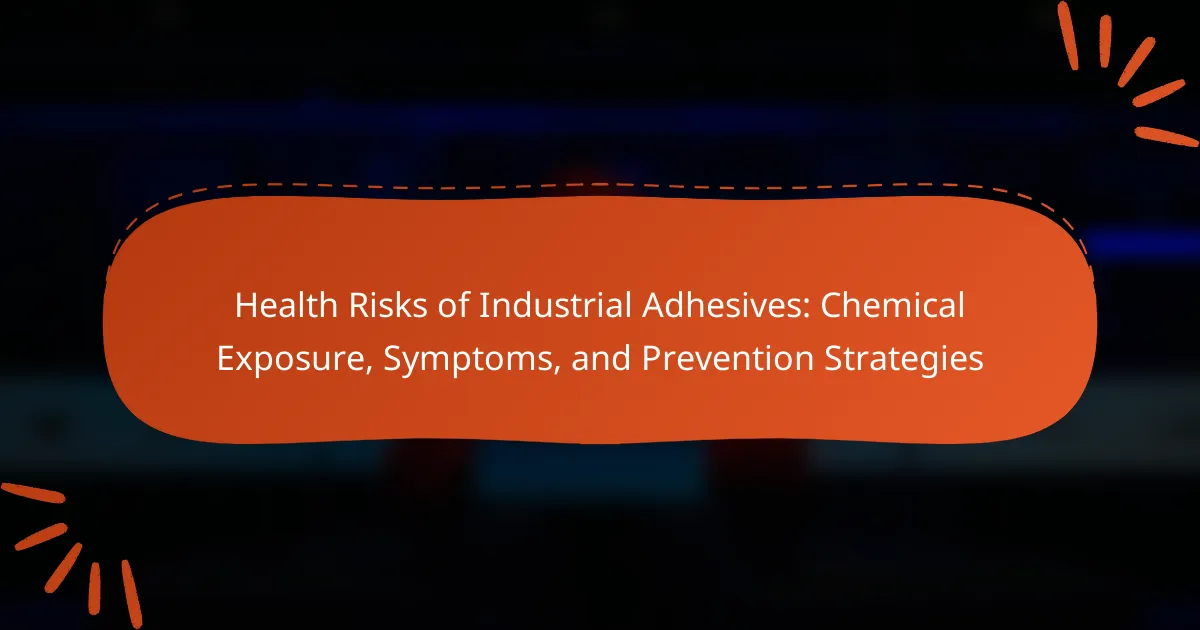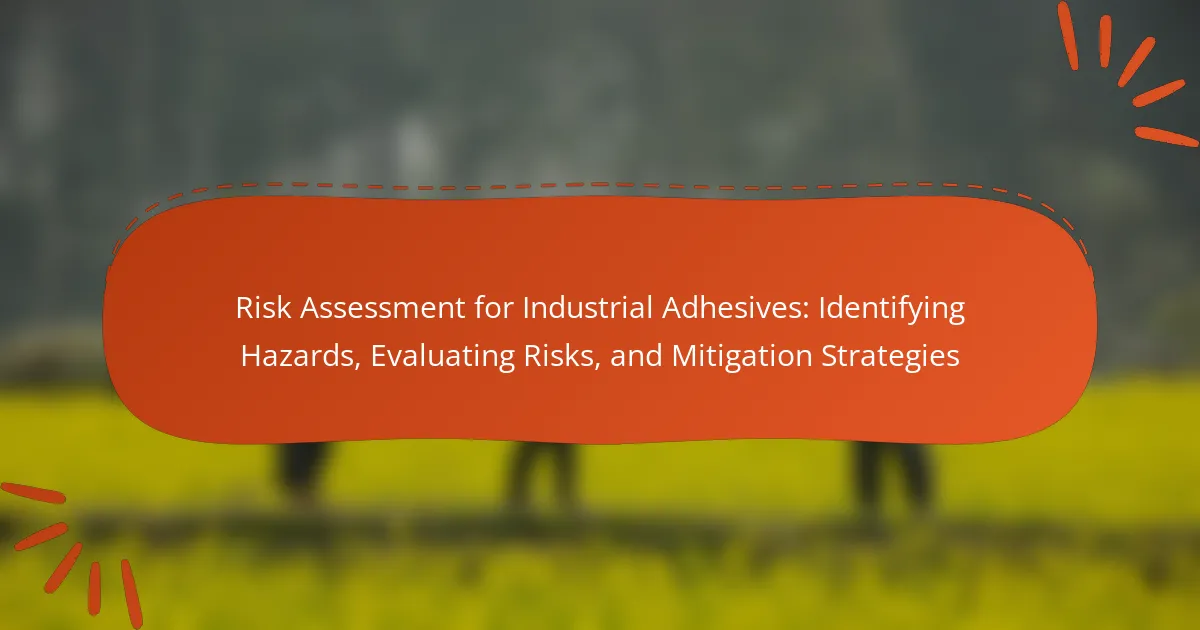Industrial adhesives are chemical compounds used in various applications that pose significant health risks due to their toxic components. Exposure to these adhesives can lead to respiratory problems, skin irritation, and allergic reactions, with long-term effects including neurological damage and increased cancer risk. Proper ventilation systems, personal protective equipment, and safe handling training are essential strategies to mitigate these risks. Regulatory standards from organizations such as OSHA and the EPA govern the safe use of these adhesives, ensuring compliance to protect worker health and safety in industrial environments. Understanding these risks and prevention strategies is crucial for maintaining a safe workplace.

What are the Health Risks Associated with Industrial Adhesives?
Industrial adhesives pose several health risks due to their chemical components. Exposure can lead to respiratory issues, skin irritation, and allergic reactions. Inhalation of fumes may cause dizziness and headaches. Long-term exposure can result in neurological damage and increased cancer risk. Specific solvents in adhesives, like toluene and formaldehyde, are known to be toxic. According to the National Institute for Occupational Safety and Health (NIOSH), these chemicals can affect the central nervous system. Proper ventilation and protective gear are essential to mitigate these risks.
How do Chemical Exposures from Industrial Adhesives Occur?
Chemical exposures from industrial adhesives occur primarily through inhalation, skin contact, and ingestion. Workers may inhale volatile organic compounds (VOCs) released during adhesive application. Skin contact can happen when adhesives are applied without proper protective gear. Ingestion may occur if workers eat or drink in contaminated areas.
Studies show that prolonged exposure to these chemicals can lead to serious health issues. For instance, the National Institute for Occupational Safety and Health (NIOSH) reports that exposure to certain adhesives can cause respiratory problems and skin irritation. Proper ventilation and personal protective equipment (PPE) are essential to minimize these risks.
What specific chemicals are commonly found in industrial adhesives?
Common chemicals found in industrial adhesives include epoxy resins, cyanoacrylate, and polyurethane. Epoxy resins are widely used for their strong bonding capabilities and resistance to environmental factors. Cyanoacrylate is a fast-acting adhesive known for its quick bonding properties. Polyurethane adhesives are valued for their flexibility and durability. Other chemicals may include solvents like toluene and xylene, which enhance adhesive properties but can pose health risks. These substances are essential for various applications, providing strength and versatility in bonding materials.
How does the application process contribute to chemical exposure?
The application process of industrial adhesives contributes to chemical exposure through direct contact and airborne contaminants. During application, workers may handle adhesives that contain volatile organic compounds (VOCs). These compounds can evaporate into the air, increasing inhalation risks. Additionally, improper ventilation during the application process can lead to higher concentrations of chemicals in the workspace. Studies indicate that prolonged exposure to these chemicals may cause respiratory issues and skin irritation. Furthermore, spills or leaks during application can lead to skin absorption and environmental contamination. Proper safety measures and protective equipment are essential to mitigate these risks.
What Symptoms are Linked to Exposure to Industrial Adhesives?
Exposure to industrial adhesives can lead to various symptoms. Common symptoms include respiratory issues such as coughing and wheezing. Skin irritation or dermatitis may also occur upon contact. Headaches and dizziness are frequently reported as well. Eye irritation can arise from adhesive vapors or splashes. In some cases, nausea may be experienced. Long-term exposure can result in more severe health effects, including neurological symptoms. These symptoms highlight the importance of proper safety measures when handling industrial adhesives.
What are the short-term effects of chemical exposure?
Short-term effects of chemical exposure include respiratory irritation, headaches, dizziness, and skin rashes. These symptoms can occur shortly after inhalation or contact with harmful chemicals. For instance, volatile organic compounds (VOCs) in adhesives can lead to immediate respiratory issues. Studies show that inhalation of certain solvents can cause acute headaches and nausea. Skin contact with adhesives may result in dermatitis or allergic reactions. The severity and type of symptoms depend on the specific chemical and level of exposure. Immediate medical attention is advised if symptoms arise.
What long-term health issues may arise from prolonged exposure?
Prolonged exposure to industrial adhesives can lead to several long-term health issues. Chronic respiratory problems may develop, including asthma and chronic obstructive pulmonary disease (COPD). Neurological effects can occur, such as cognitive decline and memory issues. Skin conditions like dermatitis may also manifest over time. Additionally, there is a risk of developing certain cancers, particularly with prolonged exposure to carcinogenic substances found in some adhesives. Studies indicate that workers exposed to these chemicals have a higher incidence of these health problems. For example, research published in the Journal of Occupational and Environmental Medicine highlights the correlation between adhesive exposure and respiratory diseases.
How Can Workers Identify Potential Health Risks from Industrial Adhesives?
Workers can identify potential health risks from industrial adhesives by reviewing Safety Data Sheets (SDS) for chemical information. SDS provide details on hazardous ingredients, exposure limits, and health effects. Workers should also observe symptoms such as headaches, dizziness, or respiratory issues while using adhesives. Monitoring ventilation and using personal protective equipment (PPE) can reduce exposure risks. Training programs on chemical safety and hazard recognition enhance awareness. Regular health check-ups can help identify long-term effects of exposure. According to the American National Standards Institute (ANSI), proper labeling and communication of hazards are essential for worker safety.
What signs should workers look for in their work environment?
Workers should look for signs of chemical exposure in their work environment. Indicators include unusual odors, which may signal hazardous fumes. Workers should also observe for symptoms like headaches or dizziness, often linked to poor ventilation. Skin irritation or rashes can indicate contact with harmful substances. Additionally, the presence of spills or leaks should raise concern about potential chemical hazards. Monitoring for excessive dust or particles in the air is crucial, as it can lead to respiratory issues. Regular inspections of safety equipment and proper labeling of chemicals are also important signs of a safe work environment.
How can symptoms be effectively monitored and reported?
Symptoms can be effectively monitored and reported through systematic tracking and documentation. Utilizing symptom diaries allows individuals to record their experiences daily. Regular check-ins with healthcare professionals enhance monitoring accuracy. Digital health applications can automate symptom tracking for convenience. Standardized reporting tools ensure consistent data collection. Training workers on recognizing symptoms increases awareness and prompt reporting. Research indicates that structured monitoring improves health outcomes in exposed populations. For instance, a study published in the Journal of Occupational Health highlighted the effectiveness of symptom surveillance in reducing long-term health risks related to chemical exposure.

What Prevention Strategies Can Reduce Health Risks from Industrial Adhesives?
Implementing effective ventilation systems can significantly reduce health risks from industrial adhesives. Proper ventilation helps to disperse harmful fumes and vapors. Using local exhaust ventilation at the source captures contaminants before they enter the worker’s breathing zone. Personal protective equipment, such as gloves and respirators, also minimizes exposure. Training workers on safe handling practices is essential for preventing accidents. Regular monitoring of air quality can identify hazardous levels of chemical exposure. Substituting less harmful adhesives can further decrease risks. Adhering to safety data sheets ensures proper understanding of the chemicals involved.
What Best Practices Should Be Implemented in the Workplace?
Implementing best practices in the workplace includes ensuring proper ventilation and using personal protective equipment (PPE). Adequate ventilation reduces airborne concentrations of harmful chemicals. PPE such as gloves, masks, and goggles protects workers from direct exposure to industrial adhesives. Regular training on safe handling and storage of adhesives is essential. This training informs employees about the risks and safe practices. Conducting routine safety audits helps identify potential hazards. Implementing a clear reporting system for health symptoms encourages prompt action. Maintaining Material Safety Data Sheets (MSDS) on site provides critical information on chemical hazards. These practices collectively enhance workplace safety and reduce health risks associated with chemical exposure.
How can proper ventilation minimize chemical exposure?
Proper ventilation minimizes chemical exposure by facilitating the removal of harmful airborne contaminants. It allows fresh air to circulate, diluting concentrations of hazardous chemicals. Effective ventilation systems can reduce the risk of inhalation of toxic fumes, vapors, and particulates. Studies show that proper ventilation can decrease indoor air pollutants by up to 80%. This reduction significantly lowers the likelihood of respiratory issues and chemical-related health problems. Regular maintenance of ventilation systems ensures optimal performance and safety.
What personal protective equipment (PPE) is essential for safety?
Essential personal protective equipment (PPE) for safety includes gloves, goggles, and respirators. Gloves protect hands from chemical exposure and skin irritation. Goggles shield eyes from harmful vapors and splashes. Respirators filter out toxic airborne particles and vapors. Additional PPE may include face shields and protective clothing. The use of PPE significantly reduces the risk of injury and health issues. According to the Occupational Safety and Health Administration (OSHA), proper PPE usage is vital in hazardous environments.
How Can Training and Education Help Prevent Health Risks?
Training and education can significantly help prevent health risks associated with industrial adhesives. Proper training equips workers with knowledge about safe handling and application techniques. Education on the potential hazards of chemical exposure is crucial for awareness. Workers who understand the symptoms of exposure can seek timely medical assistance. Additionally, training promotes the use of personal protective equipment, reducing risks. According to the Occupational Safety and Health Administration (OSHA), effective training programs can decrease workplace injuries by up to 30%. Regular educational updates ensure that workers stay informed about new safety protocols and regulations. Thus, ongoing training and education are essential in minimizing health risks in industries using adhesives.
What topics should be covered in training programs for workers?
Training programs for workers should cover chemical safety, proper handling of industrial adhesives, and personal protective equipment (PPE) usage. They must also include information on health risks associated with chemical exposure. Workers should learn to identify symptoms of exposure to hazardous substances. Training should address emergency response procedures in case of chemical spills. Additionally, programs should emphasize safe disposal methods for industrial adhesives. Understanding regulatory compliance related to chemical safety is essential. Finally, training should incorporate best practices for maintaining a safe workspace. These topics ensure that workers are well-informed and prepared to minimize health risks.
How can ongoing education contribute to safer practices?
Ongoing education contributes to safer practices by enhancing knowledge of hazards. Workers become aware of the risks associated with industrial adhesives. This awareness leads to improved safety behaviors. Training programs provide updates on safety regulations and best practices. Regular education reinforces the importance of using personal protective equipment. Studies show that companies with ongoing training report fewer accidents. For instance, a report by the National Safety Council indicates that continuous education reduces workplace injuries by 20%. Overall, ongoing education is essential for maintaining a safe working environment in industries using hazardous materials.

What Regulatory Standards Govern the Use of Industrial Adhesives?
Regulatory standards governing the use of industrial adhesives include the Occupational Safety and Health Administration (OSHA) regulations. OSHA sets permissible exposure limits for hazardous substances in the workplace. The Environmental Protection Agency (EPA) also regulates adhesives under the Clean Air Act for volatile organic compounds (VOCs). Additionally, the American National Standards Institute (ANSI) provides guidelines for adhesive performance and safety. The National Fire Protection Association (NFPA) outlines fire safety standards relevant to adhesive use. These regulations ensure safe handling and minimize health risks associated with chemical exposure. Compliance with these standards is critical for protecting worker health and safety in industrial settings.
What are the key regulations related to chemical exposure in the workplace?
Key regulations related to chemical exposure in the workplace include the Occupational Safety and Health Administration (OSHA) standards. OSHA sets permissible exposure limits (PELs) for hazardous substances. The Hazard Communication Standard requires employers to inform workers about chemical hazards. The Chemical Safety Improvement Act aims to ensure safer chemicals are used in industries. The Toxic Substances Control Act regulates the introduction of new chemicals. These regulations help protect worker health and safety. Compliance with these standards reduces the risk of chemical exposure.
How do these regulations impact the use of industrial adhesives?
Regulations significantly impact the use of industrial adhesives by enforcing safety standards. These standards limit harmful chemical exposure to workers. Compliance often requires manufacturers to reformulate adhesives to meet safety criteria. For instance, regulations may restrict volatile organic compounds (VOCs) in adhesive formulations. This leads to a rise in the use of water-based or low-VOC adhesives. Additionally, regulations mandate proper labeling and safety data sheets. This ensures users are informed about potential health risks. Ultimately, regulations promote safer working environments in industries utilizing adhesives.
What Steps Can Employers Take to Ensure Compliance with Regulations?
Employers can ensure compliance with regulations by implementing a comprehensive safety program. This program should include regular training sessions for employees on the safe handling of industrial adhesives. Employers must also conduct thorough risk assessments to identify potential hazards in the workplace. Additionally, they should maintain accurate records of all safety data sheets (SDS) for the chemicals used. Regular audits and inspections are necessary to verify compliance with safety standards. Employers should also establish clear reporting procedures for any chemical exposure incidents. Compliance with local, state, and federal regulations is essential to avoid penalties. Following these steps helps protect employee health and ensures regulatory adherence.
What documentation is necessary for compliance audits?
Compliance audits require specific documentation to ensure adherence to regulations. Key documents include safety data sheets (SDS) for all chemicals used. These sheets provide essential information on hazards and handling procedures. Additionally, records of employee training on chemical safety are necessary. Inspection reports and incident logs also play a crucial role in compliance audits. Furthermore, material usage records help track chemical consumption and exposure levels. Lastly, any relevant permits or licenses must be included to demonstrate regulatory compliance. This documentation collectively verifies that an organization meets safety and health standards related to industrial adhesives.
How can employers stay updated on changing regulations?
Employers can stay updated on changing regulations by regularly consulting government websites and industry publications. These sources provide timely updates on legal requirements. Subscribing to newsletters from regulatory agencies can also deliver important changes directly to employers. Attending industry conferences and workshops offers insights into upcoming regulations. Networking with other professionals can facilitate sharing of information on regulatory changes. Engaging legal counsel specializing in labor and environmental law ensures compliance with current regulations. Utilizing online compliance tools can help track regulatory updates efficiently. Regular training for employees on compliance issues further reinforces awareness of changing regulations.
What Practical Tips Can Help Workers Stay Safe When Using Industrial Adhesives?
Workers can stay safe when using industrial adhesives by following specific precautions. First, always read and follow the manufacturer’s safety data sheet (SDS). The SDS provides critical information about hazards and safe handling. Second, use personal protective equipment (PPE) such as gloves, goggles, and respiratory masks. PPE minimizes direct contact with harmful chemicals. Third, ensure proper ventilation in the workspace. Good airflow reduces inhalation of toxic fumes. Fourth, store adhesives in a cool, dry place away from direct sunlight. This prevents degradation and maintains effectiveness. Fifth, avoid eating or drinking in areas where adhesives are used. This practice limits ingestion of harmful substances. Lastly, attend safety training sessions regularly. Training enhances awareness of potential risks and safe practices. Following these tips significantly reduces the risk of chemical exposure.
The main entity of this article is industrial adhesives, which present various health risks due to their chemical components. Key topics covered include the health risks associated with exposure, symptoms of chemical exposure, and prevention strategies to mitigate these risks. The article discusses how chemical exposures occur, the specific chemicals commonly found in adhesives, and the short-term and long-term health issues linked to exposure. It also emphasizes the importance of proper ventilation, personal protective equipment, training, and compliance with regulatory standards to ensure worker safety in environments using industrial adhesives.



